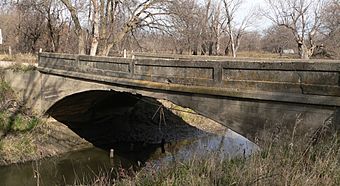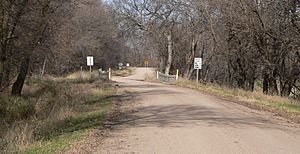Big Blue River Bridge (Grafton, Nebraska) facts for kids
Quick facts for kids |
|
|
Big Blue River Bridge
|
|

The bridge as seen from the northeast
|
|
| Location | Fillmore County Road 6, northwest of Grafton, Nebraska, U.S.A. |
|---|---|
| Area | Less than 1 acre (0.40 ha) |
| Built | 1918 |
| Architect | William A. Biba |
| NRHP reference No. | 92000745 |
| Added to NRHP | June 29, 1992 |
The Big Blue River Bridge is a special bridge in Fillmore County, Nebraska. It's located near the small village of Grafton. This bridge is so important that it's listed on the National Register of Historic Places. This means it's recognized as a significant historical site in the United States.
The Big Blue River Bridge is made of concrete and has a unique arch shape. It was designed in 1917 and built in 1918. Back then, this style of bridge was very popular in Nebraska. Even today, the bridge still has most of its original parts. It has only needed a few small repairs over the years. This old bridge carries Fillmore County Road 6 over the West Fork of the Big Blue River.
Contents
Where is the Big Blue River Bridge?
The Big Blue River Bridge is in the northwest part of Fillmore County. You can find it about five miles north and one mile west of Grafton. It sits along Fillmore County Road 6.
The bridge itself is about 52 feet long and 22 feet wide. It's just big enough to hold the bridge structure.
The Big Blue River Bridge crosses the West Fork of the Big Blue River. It's located right where School Creek flows into the river. The bridge has one lane for cars. Its surface is covered with gravel and dirt, just like the road it carries. The bridge also has a solid concrete wall on its sides, called a parapet.
Why was the Big Blue River Bridge built?
Concrete bridges in Nebraska
In the early 1900s, people in Fillmore County started trying out new ways to build bridges. They began using only concrete for construction around 1914. Concrete was thought to be stronger and last longer than steel, which was commonly used back then.
The main designs for these concrete bridges were arches and flat slabs. This building style was very common for bridges in the county until 1920. Nebraska as a state also preferred concrete for its bridges.
Designing and building the bridge
Fillmore County hired William A. Biba as its county engineer. He started trying out different bridge designs. Mr. Biba designed all of the county's bridges until 1931.
The first idea for a bridge over the Big Blue River's west fork came in June 1917. This plan was for a 40-foot long concrete arch bridge. However, we don't know if that first bridge was ever built.
Then, in May 1918, a new plan for the Big Blue River Bridge was introduced. This plan was designed by William A. Biba. The county leaders approved the plan later that month. They gave a contract worth $4,250 to a local builder named Frank N. Craven. He built the bridge later that same year.
Since it was built, the Big Blue River Bridge has stayed mostly the same. It has only had small repairs. It still carries cars and trucks today, and it's in good shape!
Why is this bridge important?
The Big Blue River Bridge was added to the National Register of Historic Places on June 29, 1992. It was chosen because of its special design and how it was built.
This bridge is important for its architecture and engineering. It shows how bridges were designed and built back in 1918. The Big Blue River Bridge is considered the best example of about 30 concrete bridges that William A. Biba designed and built. It's also one of the very first bridges he designed.
The bridge is special because it still looks and feels much like it did when it was first built. It's a great example of early 20th-century bridge building in Nebraska.





